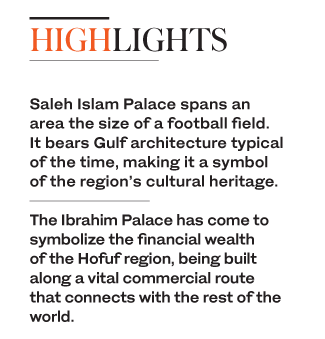JEDDAH: The first Emara Palace, built more than 65 years ago, symbolizes the rich history of the Kingdom’s Eastern Province, home to many archaeological and historical sites that have attracted visitors for years.
Formerly known as Saleh Islam Palace, it is one of the most significant landmarks in the region, in addition to the citadel in Dammam.
The palace, which spans an area the size of a football field, bears Gulf architecture typical of the time, making it a symbol of the region’s cultural heritage.
What distinguishes the five-story palace is the large, intricately decorated columns that decorate the structure from outside.
Abdullatif Al-Bunyan, director of the Saudi Commission for Tourism and National Heritage (SCTH) for the Eastern Province, said foreign delegations are officially hosted at the palace. The palace’s headquarters was moved from the Al-Ahsa region to Dammam, making it the city’s official landmark.
Ibrahim Palace in Hofuf
Built almost 500 years ago, Ibrahim Palace in Hofuf is one of Al-Ahsa region’s most significant landmarks.
Spanning an impressive 16,500 square meters, the palace combines modern and Islamic architectural styles typical of the time.
The palace includes several military watchtowers. It was said to have been renamed after Ibrahim bin Afysan, an architect who renovated the palace in 1801.
Its local imprint lies in the domes and arches that characterize its ceilings.
The palace has come to symbolize the financial wealth of the region, being built along a vital commercial route that connects with the rest of the world.
King Abdul Aziz Al-Saud added a new dimension to the palace when he ruled Al-Ahsa in 1913.
He fortified the structure with Islamic domes and huge, military-style towers, as well as soldiers’ barracks in the palace’s eastern wing.
The walls are a mixture of local mud and straw, while the roofs are made of the trunks of palm trees, wood and stone.
The palace also has a mosque depicted by several domes and a minaret with a spiral, stone-built staircase. It has a huge wooden gate with a wooden key to one side, while the muezzin’s room (a room from which someone calls for prayer) is decorated with wooden shutters.
The palace includes a service pavilion, horse stables, bedrooms for officers, an ammunition depot, toilets and several towers with communications rooms.
The palace is also characterized by barracks for Al-Ahsa’s soldiers of the time. In the middle of these barracks is a central commanding cabin with a double staircase, which is only used by officers and administrators. In fact, the commanding cabin is located in the middle of the palace’s eastern wing and divided into four rooms with two reception halls. The cabin overlooks the entirety of the palace and can only be accessed through guards. The two rooms located on the top floor have their own staircases.
Archaeological expert Wael Hassan explained that the palace barriers include a number of lookout points that offer a view over the entire region and small openings for guns and canons.
In the middle of the palace is a large hall that enabled soldiers to look down the fence for intruders.
Hassan pointed out that the palace has undergone several restorations in recent decades to preserve its architectural style. He said that the palace was opened to visitors and that the SCTH continues to holds conferences and seminars inside the palace to raise awareness about the region’s history and archaeology.
















